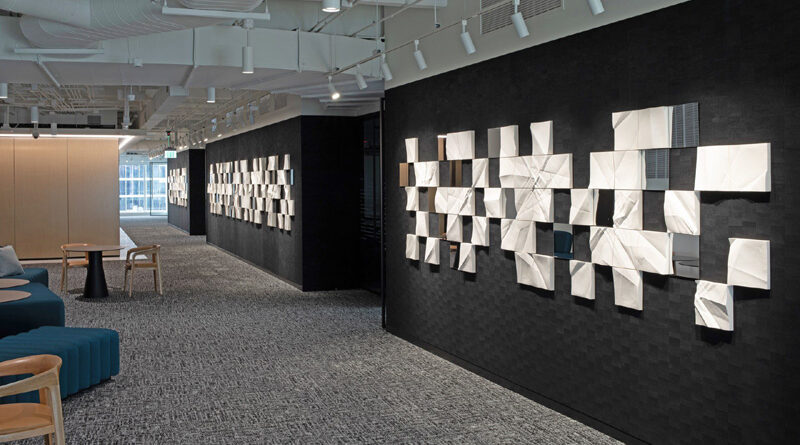Charlotte Professor Thomas Schmidt Installs Art In The Duke Energy Plaza
Employing student and alumni assistants, art professor Thomas Schmidt has created and installed a magnificent large-scale work in the Duke Energy Plaza, the company’s new headquarters at 525 South Tryon Street in uptown Charlotte. The 75-foot wall installation, comprised of some 175 porcelain panels and 50 mirrors, is named “Connected” and is based on a map of Charlotte’s electrical grid.
“I was interested in finding a way to visualize our interconnectedness in a community, particularly the kind of shared resources, the interconnection that we experience in our day-to-day lives,” Schmidt said.
Building on years of creative research, Schmidt’s process involved a fluid exchange between traditional “analog” craft techniques and new digital technologies, as he moved back and forth between 2D and 3D and physical and virtual products.
He began by digitally compiling city maps, which he then printed, marked, and manually folded along electrical grid lines – rendering the two-dimensional paper map into a subtle three-dimensional landscape.
Using a hand-held device, Schmidt 3D scanned the map to digitally capture the paper peaks and valleys and then, on his computer, divided the digital topography into a grid of 16 panels, each 12 by 12 inches.
Printed with a 3D printer, those 16 resin models were used to make plaster molds to cast porcelain tiles from liquid clay (slip), which were glazed and fired in a kiln.
Once completed, the nearly 200 porcelain tiles were then translated back into a digital format with 3D modeling software, allowing Schmidt to visualize patterns and decide on placements before physically installing the pieces.
“I could virtually create the composition in the 3D modeling software,” Schmidt explained, “and play with the flow and movement of the linear elements.”
The final work, which extends across three walls, includes 50 mirrored panels that “serve as a disruptive mechanism to the porcelain surface, altering tile, reflecting the environment, lighting – even the people as they pass through the space,” he said.
Rising senior art major Teriyana Wright worked for two months with Schmidt on “Connected.”
“Whenever Tom finished a 3D print of a panel, I would use that 3D print to create a plaster mold,” Wright said. “The information from the plastic 3D mold would transfer to the plaster and then would be saved for the next step which was the slip pouring.”
After working on “Connected,” Wright said she went to the Penland School of Craft, where she “went in with tons of knowledge” from Schmidt. “Slip casting is one of my favorite techniques. I’m going to take these skills with me forever.”
Wright, fellow student Lily Kuntz, and alumni Zainab Elrahal ’22 and Robert Houseman ’19 made up Schmidt’s production and installation team.
“By working as a team, you can work on a large scale, and be more audacious, amplifying the impact,” Schmidt said. He was particularly pleased to hire students and young alumni for such high-profile projects.
“Early in my career after undergrad, I had the opportunity to assist established artists such as Ruth Duckworth and Wayne Higby,” said Schmidt. “When I look back, these experiences completely transformed my understanding of what is possible in the studio. I want to create opportunities for the next generation of emerging artists to see and experience what it’s like to work on art outside of school.”
Elrahal (pictured) assisted Schmidt throughout the year-long project, helping to cast, clean, glaze, and fire porcelain tiles and supporting Schmidt and Houseman during the installation.
“Some of the most important things I learned during this project was how to troubleshoot issues that arose through the process,” she said. “Thinking quickly and adapting to the unpredictable nature of ceramics was very important during the whole time. I got to step into a role where I kept track of many moving parts and handled issues as they arose. I realized that project management feels like a very natural and exciting career path for me, and I am trying to pursue those positions moving forward.”
“Connected” is located in the Duke Energy Plaza’s Executive Conference Center. The area includes a centralized large conference room, a large multipurpose auditorium room, an outdoor terrace, and other spaces that encourage “connection” through in-person collaboration and events.
“We take great pride in investing in local talent and are incredibly honored to showcase this meaningful artwork in our new headquarters,” said Dwight Jacobs, senior vice president, supply chain, real estate and chief procurement officer for Duke Energy. “’Connected’ not only enhances our workspace but serves as a visual reminder for our employees – that amidst rapid change and opportunities, we must remain connected to our customers and our communities, keeping them at the heart of all we do.”

